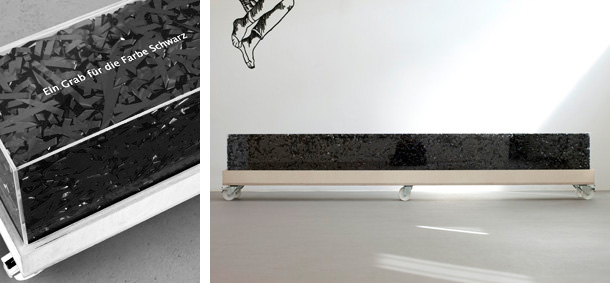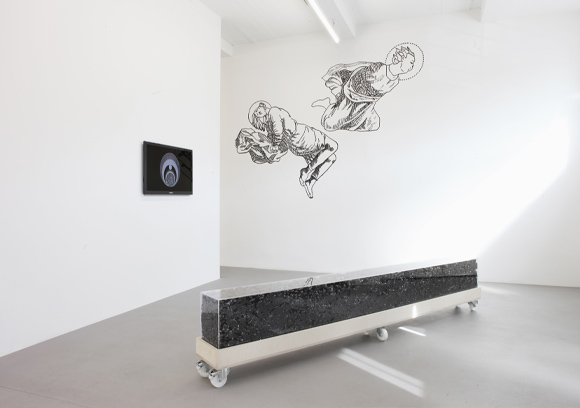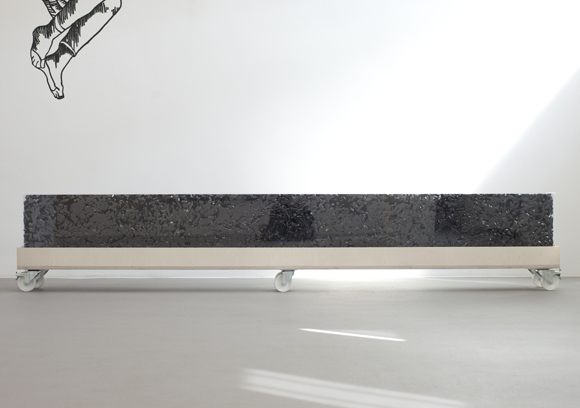| |
|
|
27.
| A Tomb for the black color |
| |


2011, tape in a plexicase on a wooden structure. 40 x 300 x 30 cm.
Exhibition view from the Angel's Black Leg, Conrads Gallery, 2011, Düsseldorf.
Courtesy of the artist and Ceysson & Bénétière, Paris.
Ed. of 5 + 1 A.P.
'' It’s the black of our collective memories, everything we would like to erase and forget. Burying the color black in order to see more clearly,
to mourn everything that has been seen up to now? Is that utopian? ''
Barbara Polla, 2012

A Tomb for the black color
Exhibition view from the Angel's Black Leg, Conrads Gallery, 2011, Düsseldorf.

A Tomb for the black color
Exhibition view from the Angel's Black Leg, Conrads Gallery, 2011, Düsseldorf.

A Tomb for the black color
Exhibition view from the Angel's Black Leg, Conrads Gallery, 2011, Düsseldorf.
|
|
|
|
|
|
Dans Grab für die Farbe Schwarz, mounir fatmi met en bière la couleur noire, posant la question de ce que serait un monde sans cette couleur qui est pourtant celle de l'encre, de l'écriture, du dessin… et en se référant en contrepoint à l'ultime phrase de Goethe, « Mehr Licht » – une phrase qui a inspiré sa grande installation présentée à la Biennale de
Lyon en 2011.
Il s'agit aussi pour fatmi d'entreprendre ici une archéologie d'un futur proche. La mort programmée des cassettes VHS, la disparition progressive des images que recèlent les bandes magnétiques de ces cassettes, la fin d'une manière de voir et de montrer le monde – et la tombe comme le lieu par excellence d'archivage et de conservation, comme un ancêtre de ce qu'on appelle maintenant le « Musée ». Il s'agit aussi d'explorer plus avant les liens entre la couleur noire et l'écriture : « la couleur noire représente pour moi avant tout des écrits, ceux qui sont venus du ciel et qui sont sacrés et ceux qui viennent de l'imagination de l'homme et retracent son histoire. » retrouvons les fantômes si chers à fatmi.
Selon l'artiste, « Notre œil est passé de l'image analogique au numérique, ce qui veut dire la mort aussi de l'idée de la "copie originale". En mode analogique, la copie avait sa fonction de copie ; elle perdait en qualité à chaque copie et l'original avait dès lors un statut plus important. Mais avec le numérique, l'original a perdu son statut puisque la copie est désormais réalisée à l'identique. »
Pour fatmi, la couleur noire représente encore, symboliquement, l'obscurantisme face aux lumières des philosophes, des penseurs libres. C'est la couleur noire de notre mémoire collective, de tout ce que nous aimerions effacer et oublier. Enterrer la couleur noire, pour voir plus clair, pour faire le deuil de ce qui a été vu jusqu'à présent ? Utopie ? Nous écririons alors à l'encre bleue - mais comment réagirait notre cerveau si on en arrivait réellement à supprimer la couleur noire.
En attendant, les bandes magnétiques de mounir fatmi magnétisent notre regard, nos désirs de voir, des images, encore, et notre pensée aussi. La tombe n'en finit pas, elle semble extensible à force d'élégance, et presque portable…
Barbara Polla, 2012.
|
|
In Grab für die Farbe Schwarz, Mounir Fatmi puts the color black to its final rest, raising the question of what the world would be like without that color, the color of ink, of writing, drawing… while referring in contrast to Goethe’s final words, “Mehr Licht”, a phrase that inspired fatmi’s large installation presented at the Lyon Biennial in 2011.
For Fatmi, this is also about creating an archeology of the near future. The programmed death of the VHS tape, the progressive disappearance of the images contained on those tapes’ magnetic ribbons, the end of a way of seeing and showing the world – and the tomb as the ultimate place for archiving and conservation, an ancestor of what is today called a “museum”.
It’s also about exploring the link between the color black and writing: “to me, the color black represents above all every type of scripture; those that came from the heavens and are sacred and those that come from man’s imagination and retrace his history.” Fatmi’s familiar ghosts are present yet again.
For the artist, “our eyes have shifted from analog to digital images, which also signifies the death of the ‘original copy’. In the analog world, a copy served its function as a copy: there was a loss in quality at every reproduction and the original therefore bore a special status. But with digital technologies, the original lost that status, as every copy is strictly identical."
For Fatmi, the color black also represents, symbolically, obscurantism as opposed to the light of philosophers and free thinkers. It’s the black of our collective memories, everything we would like to erase and forget. Burying the color black in order to see more clearly, to mourn everything that has been seen up to now? Is that utopian? We would then write using blue ink – but how would our brain react if we really managed to eliminate the color black?
In the meantime, Mounir fatmi’s magnetic tapes magnetize our gaze, our desire to see images again and again, as well as our thoughts. The tomb never ends, it seems extensible with its infinite elegance, and almost portable…
Barbara Polla, 2012.
|
|
|
|